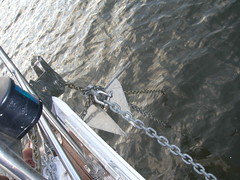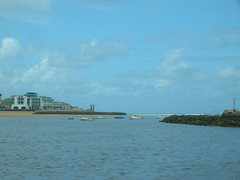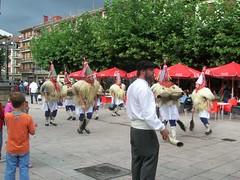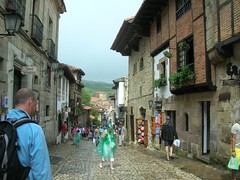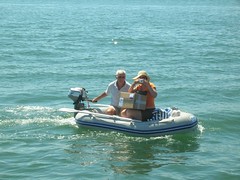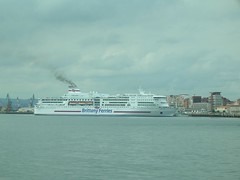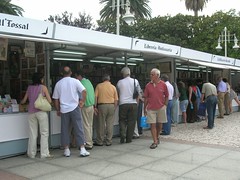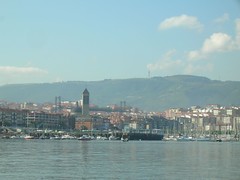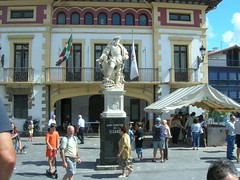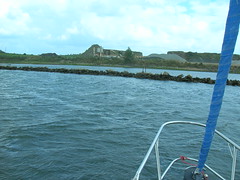 |
This wall came too close on several occasions!
|
SUNDAY 19 - MONDAY 20 AUGUST 2007
ROGER'S BLOG
It was very windy in the night and rained heavily. It didn’t look very pleasant in the morning so we spent the next day comfortably at anchor, having laid a kedge to stop us swinging with the tide. Unfortunately, there are still problems with the internet connection. It took an hour and a half discussion to find out that because the gigabyte wasn’t registered correctly at the beginning, we were being charged at the extortionate rate of 2 euros per 10 minutes, and we had used up the 60 euros! It was not possible buy another Gigabyte without going ashore. Who would have thought it would be so difficult!
The next morning Navtex was forecasting gale force 8 building to 9! However, we had noticed for the last week that the Navtex forecasts tended to be accurate for the offshore sea areas but significantly overestimated wind strength for inshore, coastal sailing. Moreover, the last check on internet weather sites (the previous day) had not indicated anything more than a Force 4 for our part of the Cantabrican coast. At the time the sun was out and the river calm, although the wind was westerly Force 4 to 5, so we decided to stay at anchor in the river and to go ashore in the dinghy.
Suances is a small coastal resort with magnificent beaches, bars and restaurants, but not much else. Nevertheless, we had a pleasant morning; posted some letters, re-provisioned and consumed a Menu del Dia. We went back to the boat and had a siesta only to awake to a Force 6 gusting 7 and the barometer dropping! Sheila decided that we should lash the dinghy on deck and put the outboard on its bracket as at this stage it was occasionally taking off as it was tied to the back of the boat! This we managed without too much difficulty and were sitting in the cockpit discussing whether to let out more chain when we started to drag towards the rocks (i.e. wall). Sheila ran forward and started getting the anchor up while I started the engine with the idea of motoring forward and re-anchoring.
The rocks were close on our port side and the north-westerly wind on our starboard bow – blowing us towards them! I put on full starboard lock and revs in an attempt to drive the bow through the wind and away from the wall. By now the wind had increased to a good Force 8 with stronger gusts and I could not get the bow through the wind. The jagged rocks were getting very close. I changed tactics and put on full port lock and just managed to clear the wall heading off upriver and downwind – the kedge anchor had remained deployed throughout this manoeuvre and was dragging behind us. We had avoided putting the boat on the rocks by only a couple of meters. At least the kedge warp was stretched tight so I had no fears of a prop-wrap at this stage. When we were in mid river I asked Sheila to drop the main delta anchor and let out 30 meters of chain. She looked at me with wide, rabbit caught in the headlights, eyes and said “I’ve cocked up”. Further enquiries elicited the fact that the anchor chain had bunched up under the windlass and was now solidly in a jam. Muttering something about not being able to get the staff, I ran forward and feverishly tugged at the tangled chain. We were drifting at about 6 knots with a good Force 8 behind us on a tangential course for the rocky wall on the opposite side of the river. I realised that I would not be able to free the chain jam in time to stop us coming into fatal contact with the wall so I hastily threw our second anchor, a 40 lb Bruce over and released 30 meters of warp – guessing that this would be short enough to hold us off the wall, but long enough for the anchor to dig in. After a few more minutes of frantic pulling at the tangled chain I managed to free it and dropped the main Delta anchor and let out 30 meters of chain.
The boat had swung head to wind as the Bruce and Delta anchors dug in, trapping the kedge warp under the boat close to the prop; we were now to all intents engineless. We watched nervously as the boat swung within a boat length of the wall and then held. Sheila, a confirmed atheist, prayed (not for the last time that night) and I changed my trousers.
There then followed the most anxious and nerve racking night I have ever spent on a boat. As the wind shifted slightly and the tide turned we swung closer to the wall, at times it appeared that we were within 2 meters! Also as the tide ebbed jagged rocks became visible at the base of the wall. Both of us stayed up all night monitoring the situation. Sheila continuously put waypoints on the chartplotter while I initially used transits. However, we were swinging so dramatically that transits proved of little use and I reverted to simply estimating the distance from the rocks. There was little we could do if we swung any closer, but we discussed two possible courses of action.
The first involved quickly releasing the kedge warp and hoping that it would float clear of the prop so we could use the engine to move away from the wall towards our brace of anchors. We buoyed the end of the kedge warp ready for this form of action, but given the wind (our instruments recorded 43 knots!) I had my doubts about whether we would be able to motor against it and the waves even assuming the warp cleared the stern.
Plan B was to run the engine in neutral, but with high revs in order to supply sufficient power to the electric windlass for us to pull ourselves clear of the wall. This would inevitably shorten our scope and therefore reduce our holding power (not to mention the enormous strain on the drive shaft of the windlass), but would have the advantage of not risking a prop-wrap.
Both of us believed that we would lose the boat, but in an attempt to minimise damage we put all our fenders out. We donned our wet weather gear and lifejackets, put flares in our pockets, rigged the searchlight, tuned the radio to channel 16 and prepared to make a mayday. Although we swung very close to the wall we survived the ebb; the flood seemed to hold us a little further away and we relaxed enough to play Boggle a scrabble type spelling game – the word “die” seemed to crop up quite a lot. Sheila was so distracted by fear, I even won a couple of games! At least we could play with all the cabin lights on and no fear of running down the batteries; the wind generator sounded like it was going to take off as it pumped in 13 amps.
Practical Boatowner magazine runs a series of articles entitled “Learning from Experience”. Well I guess we have learnt to take the worst case weather forecast as gospel.
